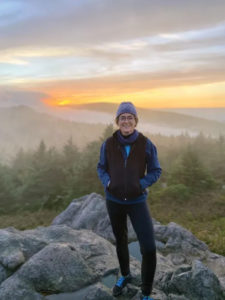The 11,000 to 12,000 trees shading the streets and parks of Lynchburg, Virginia, are a lot to keep up with. But Sarah Hagan, a 2011 University of Mary Washington graduate, has charge of them all, from roots to crowns.

As Lynchburg’s urban forester, Hagan oversees trees individually but also as an interdependent whole – the urban canopy that keeps the city healthy, vibrant and beautiful. It’s an ever-changing responsibility, varying with each season, storm, dry spell and pest. And it’s an especially pertinent position today, during National Forest Week, a celebration of America’s 193-million-acre system.
Now in her second year with Lynchburg, Hagan has dealt with the inherited problem of the emerald ash-borer, an imported pest devastating the native ash species of the eastern to midwestern United States. Almost all the city’s ash trees have had to be removed.
City trees face other stresses as well, from improper planting, poor soil and road salt. Hagan constantly evaluates how long Lynchburg’s trees are lasting, how their lives can be extended and how to bolster the overall health and sustainability of the resource. To handle it all she works with Lynchburg’s public works department, a contract crew and a corps of citizen volunteers known as tree stewards.
The role seems ideal for a biology major with a passion for botany, hiking and all things outdoors. But getting there involved “a lot of zigs and a lot of zags,” Hagan said. “My 16-year-old self and my 33-year-old self, I think, would find each other amusing.”
Growing up in Botetourt County near Roanoke, Hagan was an arts-oriented kid whose physician mother and lawyer father encouraged her musical pursuits. Only after studying music at another Virginia college did she conclude that she wouldn’t have a career as an opera singer.
But if not music, what would be a more practical choice?
“I had always hated math and science,” she said. “But I decided, ‘I’m going to learn science.’”
She researched biology programs and decided to give Mary Washington’s highly regarded Department of Biological Sciences a try. Professors including Stephen Fuller, Joella Killian, Andrew Dolby and Deborah O’Dell welcomed, challenged and encouraged her.
“Mary Washington taught me science,” Hagan said. “My first semester, I walked into Dr. Fuller’s botany class with no idea even how to prep a slide. I fell in love with it. I adored it. I just couldn’t get over the miraculous organisms that plants are.”
It felt great to succeed in a notoriously difficult class, and it set her on an academic and career path she finds rewarding. “I was hooked because plants were just so darn cool, and I wanted more.”
And she loved living in Fredericksburg. As an older transfer student, she lived with roommates off campus, developed a great community of friends and sang in the choir of St. George’s Episcopal Church. After graduating cum laude from UMW, she worked another three years in the area, chiefly in an Americorps-funded position as volunteer and stewardship coordinator for Friends of the Rappahannock.
As her interest in conservation grew, she applied to graduate school and eventually earned a master’s degree in environmental management from Duke University, with a focus on forestry and forest management.
While these days Hagan sings mostly in the shower and the car – her mother still urges her to join a choir for fun – she’s satisfied with a scientific calling that keeps her outdoors much of the time and contributes to everyone’s well-being.
“I’m happy where I am,” she said, “because I get to do something that’s having a positive influence on future generations.”
This story, written by Laura Moyer, associate editor of University of Mary Washington Magazine, originally appeared in the spring/summer 2021 issue.